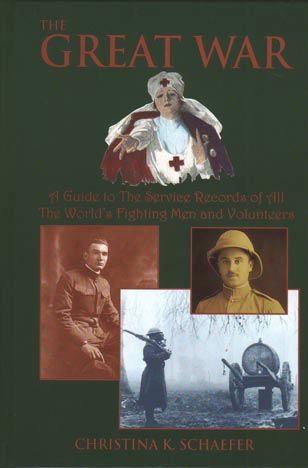Because Footnote.com made the name change to fold3.com, and their change in emphasis to being principally a military records website, I got to thinking about my 20th-Century war-related research. World War I was three decades in the past by the time I was born, but my family was directly affected by it. My father was too young for service, being only 14 years old when the USA entered the conflict. However, he joined the U.S. Army when he was 17, lying about his age to get in, and serving in China, as well as the PhilipPines. One of my cousins, Lloyd Titus, from Michigan died in the conflict and is buried in the Meuse-Argonne American Cemetery, Romagne, France. A number of Meitzler cousins still living in Germany died fighting with the German Army.
The principle book on World War One genealogy research is titled, The Great War – A Guide to the Service Records of All The World’s Fighting Men and Volunteers, by Christina K. Schaeffer. The book was published in 1998, and reprinted in 2006 – and is still available in an extremely attractive hard-cover edition.
 World War I has passed from living memory into the history books, receding far enough into the distance to provide a genealogical challenge. In order to reconstruct the lives and locate the records of those who served, fought, volunteered, or were conscripted, we must rely on a vast but relatively unknown body of resources. Counting all combatants, the number of men who served in the Great War runs into the millions. Needless to say, finding records on them in the two dozen countries that participated in the war is a daunting and laborious task – made infinitely simpler with the use of this guide to WWI service records. The only book of its kind, this ambitious effort to catalogue service records and related sources is international in scope, covering the soldiers of all countries participating in the war, from Britain, Germany, and France, to Russia, Canada, and the U.S.; and from India, Australia, and Japan, to South Africa and Brazil!
World War I has passed from living memory into the history books, receding far enough into the distance to provide a genealogical challenge. In order to reconstruct the lives and locate the records of those who served, fought, volunteered, or were conscripted, we must rely on a vast but relatively unknown body of resources. Counting all combatants, the number of men who served in the Great War runs into the millions. Needless to say, finding records on them in the two dozen countries that participated in the war is a daunting and laborious task – made infinitely simpler with the use of this guide to WWI service records. The only book of its kind, this ambitious effort to catalogue service records and related sources is international in scope, covering the soldiers of all countries participating in the war, from Britain, Germany, and France, to Russia, Canada, and the U.S.; and from India, Australia, and Japan, to South Africa and Brazil!
The early portion of the book is designed to provide background on the organization of the military in 1914, the order of battle, how to use the records, and a general time-line of events, focusing on 1914 to 1918.
The second portion concentrates on the combatants, describing each country’s armed forces, conscription history, and its military and naval records, and, to the greatest extent possible, their location. Records that have been microfilmed and are available worldwide through the FamilySearch LDS branch libraries are identified by roll number.
The third portion of the book describes casualty lists and POW records, and provides a table showing changes in place names.
The last portion of the book, an appendix, contains a glossary of abbreviations, Internet addresses, and a select bibliography of books written in English.
The disposition of personnel files varies from country to country, depending on privacy laws and archival practices. In some cases documents are held by a military archive, in others by a national repository. In a few cases, such as Great Britain, service files have been transferred from one agency to another. Whatever their disposition – and it is an important aim of this book to identify their disposition – the records covered here fall under the following headings:
- Draft records,
- Personnel papers,
- Unit records,
- Embarkation lists,
- Death records and casualty reports,
- Military parish registers,
- Regimental returns,
- Medal lists,
- Entitlement lists,
- Hospital registers,
- Pension records,
- and diaries.
A particularly useful section of the book, “Research Tips,” describes the general organization of military records, the organization of those records in specific countries, and the condition and comprehensiveness of the records.
With help from dozens of individuals and institutions throughout the world, including the U.S. Army Pentagon Library, the Navy Department Library, the Library of Congress, the Family History Library, the Hoover Institute (Stanford University), the Public Record Office (England), and the national archives of at least a dozen countries, the author compiled a guide to WWI service records that is not only unique, but comprehensive in scope.
The following is from the Table of Contents:
Table of maps and illustrations (21 items are listed)
Preface
1. THE HISTORY
Research Tips
Time line
2. THE COUNTRIES
Australia and New Zealand
Austria-Hungary
Belgium
Brazil
Bulgaria
Canada and Newfoundland
France
Germany
Great Britain
Greece
India
Italy
Japan
Luxembourg
The Ottoman Empire
Poland
Portugal
Romania
The Russian Empire
Serbia and Montenegro
South Africa
The United States
The Neutral Countries
3. AFTERMATH
Casualties and prisoners of war
New countries
APPENDIX
Information on the Internet
Glossary and abbreviations
Selcted bibliography
INDEX
The Great War, by Christina K. Schaffer, 203 pp, 8×9, hard cover. Click here for more information, or to order the volume for your research library.